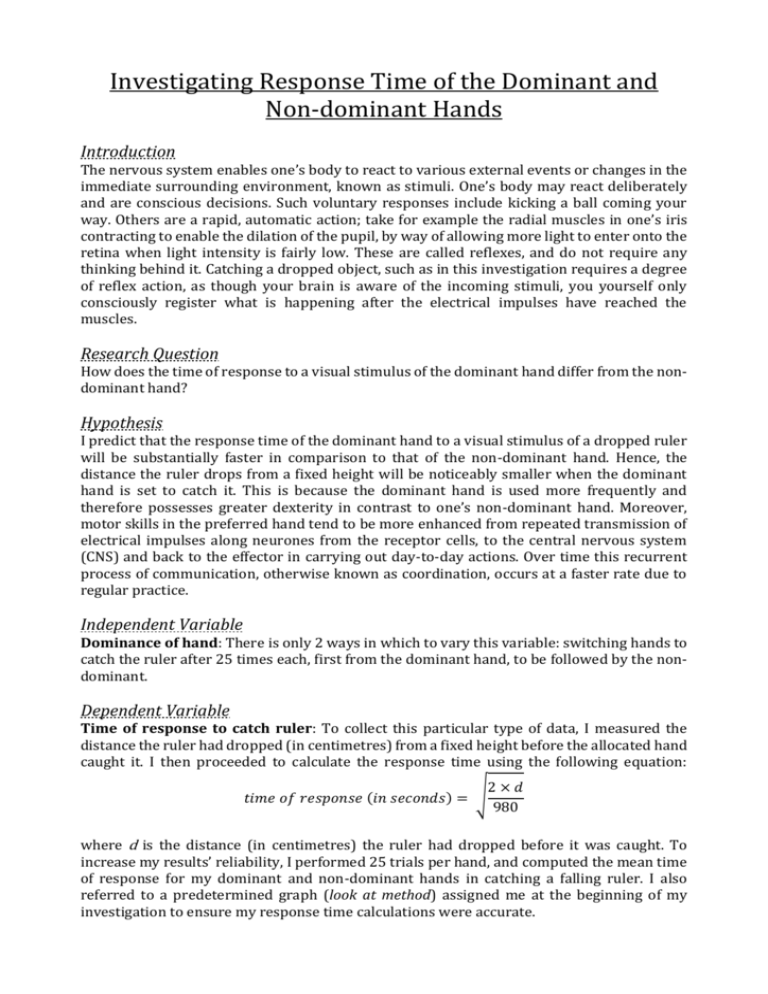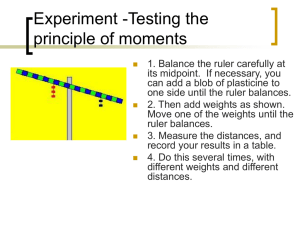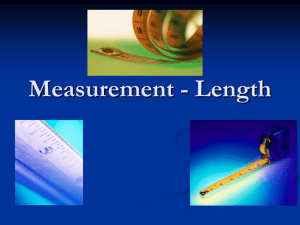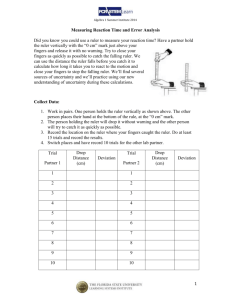Response Time Lab Report - Mr Waring`s Biology Blog
advertisement

Investigating Response Time of the Dominant and Non-dominant Hands Introduction The nervous system enables one’s body to react to various external events or changes in the immediate surrounding environment, known as stimuli. One’s body may react deliberately and are conscious decisions. Such voluntary responses include kicking a ball coming your way. Others are a rapid, automatic action; take for example the radial muscles in one’s iris contracting to enable the dilation of the pupil, by way of allowing more light to enter onto the retina when light intensity is fairly low. These are called reflexes, and do not require any thinking behind it. Catching a dropped object, such as in this investigation requires a degree of reflex action, as though your brain is aware of the incoming stimuli, you yourself only consciously register what is happening after the electrical impulses have reached the muscles. Research Question How does the time of response to a visual stimulus of the dominant hand differ from the nondominant hand? Hypothesis I predict that the response time of the dominant hand to a visual stimulus of a dropped ruler will be substantially faster in comparison to that of the non-dominant hand. Hence, the distance the ruler drops from a fixed height will be noticeably smaller when the dominant hand is set to catch it. This is because the dominant hand is used more frequently and therefore possesses greater dexterity in contrast to one’s non-dominant hand. Moreover, motor skills in the preferred hand tend to be more enhanced from repeated transmission of electrical impulses along neurones from the receptor cells, to the central nervous system (CNS) and back to the effector in carrying out day-to-day actions. Over time this recurrent process of communication, otherwise known as coordination, occurs at a faster rate due to regular practice. Independent Variable Dominance of hand: There is only 2 ways in which to vary this variable: switching hands to catch the ruler after 25 times each, first from the dominant hand, to be followed by the nondominant. Dependent Variable Time of response to catch ruler: To collect this particular type of data, I measured the distance the ruler had dropped (in centimetres) from a fixed height before the allocated hand caught it. I then proceeded to calculate the response time using the following equation: 𝑡𝑖𝑚𝑒 𝑜𝑓 𝑟𝑒𝑠𝑝𝑜𝑛𝑠𝑒 (𝑖𝑛 𝑠𝑒𝑐𝑜𝑛𝑑𝑠) = √ 2×𝑑 980 where d is the distance (in centimetres) the ruler had dropped before it was caught. To increase my results’ reliability, I performed 25 trials per hand, and computed the mean time of response for my dominant and non-dominant hands in catching a falling ruler. I also referred to a predetermined graph (look at method) assigned me at the beginning of my investigation to ensure my response time calculations were accurate. Control Variables Height From Which Ruler Was Dropped (cm) Distance of Thumb and Forefinger from the Ruler (cm) Position of Eye in relation to the Ruler Warning of Imminent Stimulus Level of Caffeine (mg) Apparatus A metric ruler of 30 cm The height from which my partner was tasked to drop the ruler was required to be a fixed distance from my waiting fingers. To accomplish this, I rested my arm along the bench top, as a reference point that will never fluctuate throughout the experiment as the bench is stationary, and therefore my hand level will not change. My partner then proceeded to hold and suspend the ruler so that the zero mark was level and perpendicular to my hand. This way, the ruler will remain a 30 cm distance from my prepared hand throughout. It is essential that the gap between the thumb and forefinger when enclosing the bottom edge/zero mark of the ruler is approximately 2 cm apart, with the ruler an equal distance from them both. This is slightly more difficult to regulate, as fingers held in that specific position tend to quiver slightly in anticipation of a falling object. This can cause the distance between the fingers and the ruler to lessen, effectively minimizing the distance required to grasp the dropped ruler and lower the reaction time, and vice versa if the distance increases to more than 2 cm. The angle/distance of my eye to the ruler must not vary between trials, or during the switching of hands from the dominant to the non-dominant, as the visual stimulus of a ruler falling perceived by direct vision will produce a faster reaction time as opposed to when detected with peripheral vision. Cone cells from when one is looking directly at any stimuli will identify any changes faster than by rod cells around the eye’s periphery, prompting faster reflex actions. To ensure a constant eye position, I sat on the same chair throughout the investigation, a fixed height from the bench top where the ruler’s zero mark rests. It is necessary for my partner holding the ruler upright to warn me by saying “Ready”, and dropping the ruler without any further warning. She must also be careful to do so within a five second timeframe, as it is difficult to maintain concentration or muscular tension at the highest degree for any time longer than a few seconds. As a stimulant drug, it is necessary to ensure that caffeine is not ingested in between trials, or before switching from the dominant hand to the non-dominant. The quantity of caffeine in coffee, for example, is capable of decreasing one’s reaction time to any form of stimulus, be it visual, auditory or touch, and strengthen resistance to distraction that can inhibit the time it takes to response. Moreover, the minimal lag time required for caffeine to take effect after consumption will also cause a greater portion of the data recordings to be affected, leading to an unbalanced overall results table. Chair / stool Table / bench top Pencil Measuring tape Method I. Work in pairs. Position your partner by a bench, whilst holding a ruler between his/her thumb and forefinger, ensuring that the bottom edge or the zero mark hangs level with the bench top. II. Sit yourself on a chair and rest your dominant arm (on its side) flat across the bench top, aligning your wrist along the bench’s edge, so as to not allow your hand to be in direct contact with the bench’s surface. III. Enclose the zero mark of the ruler with your thumb and forefinger on either side of it, ensuring the two fingers are an approximate 2 cm distance apart, with the ruler directly in the center between them. IV. Your partner holding the ruler will say, “Ready” and drop it at any given moment within 5 seconds. Your task is to catch the ruler by grasping it with your readied thumb and forefinger. V. Record the distance the ruler dropped (in centimetres) in a table by noting the mark at which the top of your forefinger pinched the ruler. VI. Reset the arrangement of your exercise according to steps I, II and III. Proceed to then perform steps IV and V again to receive 25 trials worth of measurements (for your dominant hand to catch a ruler). VII. Switch to your non-dominant hand and repeat step VI. VIII. Once all the readings have been taken for both hands, calculate the mean distance dropped by the ruler before the respective hand caught it, by adding all the values together to then be divided by 25. IX. Compute the reaction time of each hand in catching the ruler for all 50 trials (25 each) based on the following equation: 𝑡𝑖𝑚𝑒 𝑜𝑓 𝑟𝑒𝑠𝑝𝑜𝑛𝑠𝑒 (𝑖𝑛 𝑠𝑒𝑐𝑜𝑛𝑑𝑠) = √ 2×𝑑 980 where d equals to the distance dropped by ruler (in cm) before caught. Calculate the mean response time for the dominant and non-dominant hand by adding all the values together before dividing the answer by 25. Record this in your table. To ensure your calculations are accurate, refer the mean response time determined by the equation with the preset graph below, using the mean value calculated in step VIII as your distance dropped by ruler (in cm). Sample Computation TO CALCULATE TIME OF RESPONSE (in seconds) SUBJECT A: TRIAL 25 OF DOMINANT HAND distance dropped by ruler before caught (cm): 15.5 2×𝑑 𝑡𝑖𝑚𝑒 𝑜𝑓 𝑟𝑒𝑠𝑝𝑜𝑛𝑠𝑒 (𝑖𝑛 𝑠𝑒𝑐𝑜𝑛𝑑𝑠) = √ 980 d = distance dropped by ruler 2 × 𝟏𝟓. 𝟓 𝑡𝑖𝑚𝑒 𝑜𝑓 𝑟𝑒𝑠𝑝𝑜𝑛𝑠𝑒 (𝑖𝑛 𝑠𝑒𝑐𝑜𝑛𝑑𝑠) 𝑓𝑜𝑟 𝑇𝑅𝐼𝐴𝐿 25 = √ 980 = 0.18 TO CALCULATE MEAN RESPONSE TIME (in seconds) of SUBJECT A’s DOMINANT HAND = = 𝑠𝑢𝑚 𝑜𝑓 𝑎𝑙𝑙 𝑣𝑎𝑙𝑢𝑒𝑠 𝑛𝑢𝑚𝑏𝑒𝑟 𝑜𝑓 𝑡𝑟𝑖𝑎𝑙𝑠 0.17 + 0.16 + 0.16 + 0.17 + 0.12+. . . +0.18 25 = 𝟎. 𝟏𝟓 𝑠𝑒𝑐𝑜𝑛𝑑𝑠 Further Calculations TO CALCULATE SPEED AT WHICH NERVE IMPULSE TRAVELLED (cm/s) in SUBJECT A’s DOMINANT HAND 𝑠𝑝𝑒𝑒𝑑 𝑜𝑓 𝑛𝑒𝑟𝑣𝑒 𝑖𝑚𝑝𝑢𝑙𝑠𝑒 (𝑐𝑚⁄𝑠) = 𝑑𝑖𝑠𝑡𝑎𝑛𝑐𝑒 𝑓𝑟𝑜𝑚 𝑒𝑦𝑒 𝑡𝑜 𝑓𝑜𝑟𝑒𝑓𝑖𝑛𝑔𝑒𝑟 (𝑐𝑚) 𝑚𝑒𝑎𝑛 𝑡𝑖𝑚𝑒 𝑜𝑓 𝑟𝑒𝑠𝑝𝑜𝑛𝑠𝑒 𝑡𝑜 𝑐𝑎𝑡𝑐ℎ 𝑡ℎ𝑒 𝑟𝑢𝑙𝑒𝑟 (seconds) 𝑠𝑝𝑒𝑒𝑑 𝑜𝑓 𝑛𝑒𝑟𝑣𝑒 𝑖𝑚𝑝𝑢𝑙𝑠𝑒 (𝑐𝑚⁄𝑠) = 99 𝑐𝑚 0.15 𝑠𝑒𝑐𝑜𝑛𝑑𝑠 = 𝟔𝟔𝟎 TO CALCULATE SPEED AT WHICH NERVE IMPULSE TRAVELLED (cm/s) in SUBJECT A’s NON – DOMINANT HAND 𝑠𝑝𝑒𝑒𝑑 𝑜𝑓 𝑛𝑒𝑟𝑣𝑒 𝑖𝑚𝑝𝑢𝑙𝑠𝑒 (𝑐𝑚⁄𝑠) = 𝑑𝑖𝑠𝑡𝑎𝑛𝑐𝑒 𝑓𝑟𝑜𝑚 𝑒𝑦𝑒 𝑡𝑜 𝑓𝑜𝑟𝑒𝑓𝑖𝑛𝑔𝑒𝑟 (𝑐𝑚) 𝑚𝑒𝑎𝑛 𝑡𝑖𝑚𝑒 𝑜𝑓 𝑟𝑒𝑠𝑝𝑜𝑛𝑠𝑒 𝑡𝑜 𝑐𝑎𝑡𝑐ℎ 𝑡ℎ𝑒 𝑟𝑢𝑙𝑒𝑟 (seconds) 𝑠𝑝𝑒𝑒𝑑 𝑜𝑓 𝑛𝑒𝑟𝑣𝑒 𝑖𝑚𝑝𝑢𝑙𝑠𝑒 (𝑐𝑚⁄𝑠) = 101 𝑐𝑚 0.18 𝑠𝑒𝑐𝑜𝑛𝑑𝑠 = 𝟓𝟔𝟏 Conclusion The response time of the dominant hand to a visual stimulus of a dropped ruler is significantly faster than that of the non-dominant hand. This is illustrated clearly by the column chart wherein the three bars indicating the mean response times of the class, subject A and subject B’s dominant hand are noticeably smaller in height than their respective counterparts in the non-dominant hand category, demonstrating a substantial difference when it comes to how fast both hands react in contrast with each other. All three sets of data support my hypothesis. The neural pathway undertaken by electrical impulses to catch a falling ruler in this investigation is as follows: stimulus (ruler drops) (sensory) receptor cells in eyes sensory neurones the central nervous system (specifically the spinal cord) motor neurones effector (hand/finger muscles) response (contraction of hand/finger muscles to catch ruler) The transmission of nerve impulses according to the above stated route, occurs at a faster rate in the dominant hand in comparison to the non-dominant, due to the regular handling of day-to-day actions with the preferred hand, inducing more dexterity from frequent practice and accounting for faster reaction times. This is proven by subject A’s (dominant hand) mean response time of 0.15 seconds producing a 660 cm/s reflex speed, 18% faster than the nondominant hand’s 561 cm/s, whose mean reaction time was a lengthier 0.18 seconds. As seen from the results table and the column chart, subject B has a considerably more enhanced dominant hand compared to her non-dominant, with a 36% increase in reaction time when she employs the use of her preferred hand. This in contrast to subject A, whose reaction time when catching the ruler with her dominant hand is only 20% faster as to when she switches to her non-dominant, indicates that there might be some external factor that affects the time it takes to respond to a visual stimulus. It is interesting to note that subject B is a student particularly active in the field of sport, whereas subject A is more of an introvert. This circumstance possibly contributes to subject B’s more prominent difference between her preferred and less preferred hand’s response times, as it is very rare that the nondominant limb is used in sport (for example, when throwing or catching a ball). The avid participation in sport would also account for subject B’s faster response time in the dominant hand than subject A’s. It wasn’t particularly ideal to compare the class’s mean response time for their dominant and non-dominant hands with subjects A’s and B’s. This is because the number of trials performed by each student varies between every pair, leading to a variable level of reliability when collecting the results in to compute a mean. And so, plotting the class value against subjects A and B (who both performed 25 trials per hand) would not make for a fair comparison. Several of the distances the ruler dropped before the allocated hand caught it were anomalous results (highlighted red in the data table). To prevent the mean time of response being affected, I plotted a separate column chart to identify the range in which most of the points stayed within, and repeated any that went beyond that zone. Through this method, I eliminated any anomalies from my results table. This however produces a certain degree of inconsistency in my values, as a portion of my recordings is not part of the raw data. Evaluation A strength of my investigation was that both subjects (myself and my partner) performed 25 trials for both our dominant and non-dominant hands. This enabled us to compute a mean reaction time in response to a visual stimulus, consequently improving the reliability of our results. However, the drawback to this was that each hand was receiving more practice the longer the investigation wore on with the increasing number of trials. Therefore, we were able to adapt to the nature of the impending stimulus, and anticipate it with more sureness. The motor skills of our hands improved the more times we performed the exercise, which would lead to a decline in our overall mean response times. To rectify this, and still maintain a fairly high level of reliability, we should aim to perform between 10 to 15 trials, as any number greater than that will aid us in enhancing our reaction times, instead of examining them to compare the reflexes of the preferred hand and the less preferred. Another strength of our experiment was the identification of anomalies within the 25 trials performed per hand, through plotting a column chart. This enabled us to distinguish which values were far off the general zone most bars strayed into. To eliminate these anomalous results, we performed the trial a second time to receive an improved reading. A weakness of our investigation was the method with which we used to record the response times of our dominant and non-dominant hands. Catching a ruler requires measurements to be taken manually, which, especially since we are noting what position the top of our fingers are grasping the ruler, may lead to parallax errors. The degree of precision is also not particularly high, as with a ruler, one can only measure to 1 decimal place accurately, and even that can be jeopardized by the fingers obscuring the ruler markings. To improve the quality of our results and its reliability from the reduce of human errors, we should use a mouse, and a computer as both the visual stimulus and to record the response times. With this setup of equipment, one must switch from the dominant hand to the non-dominant to click the mouse button as soon as they perceive a particular image or animation on the monitor screen. The computer will automatically record an accurate value of the response time once the button is clicked. This will minimize any random or human errors committed during our investigation. Another weakness of our experiment was the loud, classroom environment our investigation was conducted in. The commotion and noise served only as a distraction, one that possibly inhibited a faster reaction time, as concentration on the imminent stimulus was not 100%. In future experiments, students should be spread out in multiple laboratories so as to minimalize any distraction that can hinder the acquiring of as good results as possible.






![Measuring Reaction Times (modified) [word document]](http://s3.studylib.net/store/data/005890593_1-f3403f0a4fee937a93ebd23d2df416ab-300x300.png)

